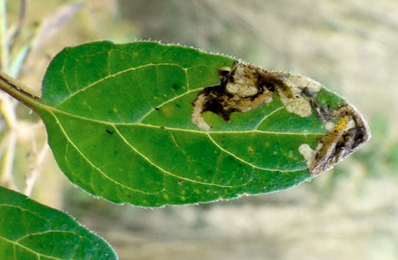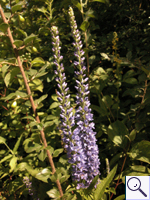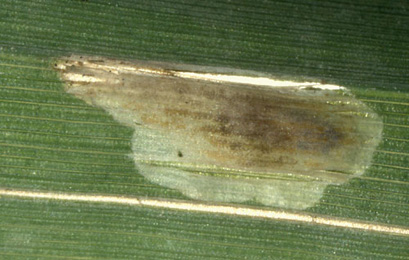|
||||||
|
VERONICA. Speedwells. [Scrophulariaceae] |
|
|
Forty species of Veronica are recorded in Britain. Seventeen of these are native. The BSBI provide a downloadable plant crib for Veronica. Spiked Speedwell (V. spicata) and Fingered Speedwell (V. triphyllus) are protected under Schedule 8 of the Wildlife and Countryside Act, 1981. Six British miners are recorded on Veronica. A key to the European miners recorded on Veronica is provided in Bladmineerders van Europa.
|
|
Key for the identification of the known mines of British |
Note: Diptera larvae may live in a corridor mine, a corridor-blotch mine, or a blotch mine, but never in a case, a rolled or folded leaf, a tentiform mine or sandwiched between two more or less circular leaf sections in later instars. Pupation never in a cocoon. All mining Diptera larvae are leg-less maggots without a head capsule (see examples). They never have thoracic or abdominal legs. They do not have chewing mouthparts, although they do have a characteristic cephalo-pharyngeal skeleton (see examples), usually visible internally through the body wall. The larvae lie on their sides within the mine and use their pick-like mouthparts to feed on plant tissue. In some corridor miners frass may lie in two rows on alternate sides of the mine. In order to vacate the mine the fully grown larva cuts an exit slit, which is usually semi-circular (see Liriomyza huidobrensis video). The pupa is formed within the hardened last larval skin or puparium and as a result sheaths enclosing head appendages, wings and legs are not visible externally (see examples). See Key to non-Diptera. |
1a > Leaf-miner: Mine normally begins along margin of leaf, sometimes later developing into a secondary blotch. Pupation takes place on the lower surface of the leaf, with the anterior spiracles normally projecting through the epidermis (Spencer, 1972b: 82, 83 (fig. 271). Wide upper-surface corridor. The first part closely follows the leaf margin. Later the margin is released, often then the corridor is so densely wound that a secondary blotch is formed. Finally a short short stretch is made that ends in a lower-surface puparial chamber. Frass in isolated grains or pearl chains. Forms a narrow mine which follows the leaf margin, then turns and forms a secondary blotch. Pupation is in the mine. |
|
| Phytomyza crassiseta Zetterstedt, 1860 [Diptera: Agromyzidae]. |
| 1b > Leaf-miner: Irregular mine, locally shallow, elsewhere much deeper, giving it a mottled appearance. In broadleaved plants the mine often begins as a blotch with stellate extensions, but sometimes as a very fine, shallow corridor. In grasses the mine often begins in the leaf sheath. The frass is very fine-grained, initially scattered, later in aggregates. The egg is deposited on the plant surface, and the empty egg shell remains visible. But the larvae are able to leave their mine and restart elsewhere, thus mines without an egg shell can be found as well. The larva also leaves the mine before pupation. Pupation takes place in a newly made, small, blotch mine without frass; this mine may be made in another plant (species). |
|
|
| Hydrellia griseola (Fallén, 1813) [Diptera: Ephydridae]. |
1c > Leaf-miner: A distinctive mine primarily above mid-rib, with irregular short lateral offshoots into leaf blade. Pupation external (Spencer, 1972: 51 (fig. 172), 55; Spencer, 1976: 270, 271 (fig. 486)). Branched, whitish, upper-surface corridor; main axis overlying the midrib; side branches overlying the main lateral veins. (In Campanula and Phyteuma the mine is much less branched, sometimes nothing more than a corridor on top of the midrib). Frass in rather long strings. Usually the mines begins as a long and narrow, shallow, tortuous lower-surface corridor that ends upon the midrib but otherwise is not associated with the leaf venation. Often this initial corridor is filled with callus, and then even less conspicuous. Pupation outside the mine. A linear mine on the upper surface, usually following the midrib and showing side branches along the veins. The frass is in strings. |
|
Liriomyza strigata (Meigen, 1830) [Diptera: Agromyzidae]. |
|
Key for the identification of the known mines of British |
1a > Leaf-miner: Rather long corridor winding through the leaf, regularly crossing itself. The corridor later widens considerably. Frass normally in a narrow central line, but may also lie along the side, or be absent. The larva regularly leaves a mine and restarts elsewhere. |
|
Apteropeda globosa (Illiger, 1794) [Coleoptera: Chrysomelidae]. |
| 1b > Leaf-miner: Rather long full depth corridor that winds freely through the leaf and may cross itself. In the end the corridor widens considerably. Frass mostly in a narrow central line, but may also be deposited along the sides or be missing. The larvae regular leave a mine to restart elsewhere. Pupation outside the mine. Neither larva or mine can be distinguished from that of related species. |
|
Apteropeda orbiculata (Marsham, 1802) [Coleoptera: Chrysomelidae]. |
1c > Leaf-miner: Rather narrow corridor, untidy and sometimes branched, starting from the base of the leaf, in particular the midrib. Sides of the corridor irregularly eaten out, not really parallel. Frass mostly present, and then in a central line. The larva is capable of leaving the mine and start a new one elsewhere. These later mines are much broader, and the frass is scattered irregularly.. |
 Mine of Orthochaetes insignis on Prunella vulgaris Image: © Jean-Yves Baugnée (Bladmineerders van Europa) |
|
Orthochaetes insignis (Aube, 1863) [Coleoptera: Curculionidae]. |
| Last updated 13-Feb-2018 Brian Pitkin | ||


